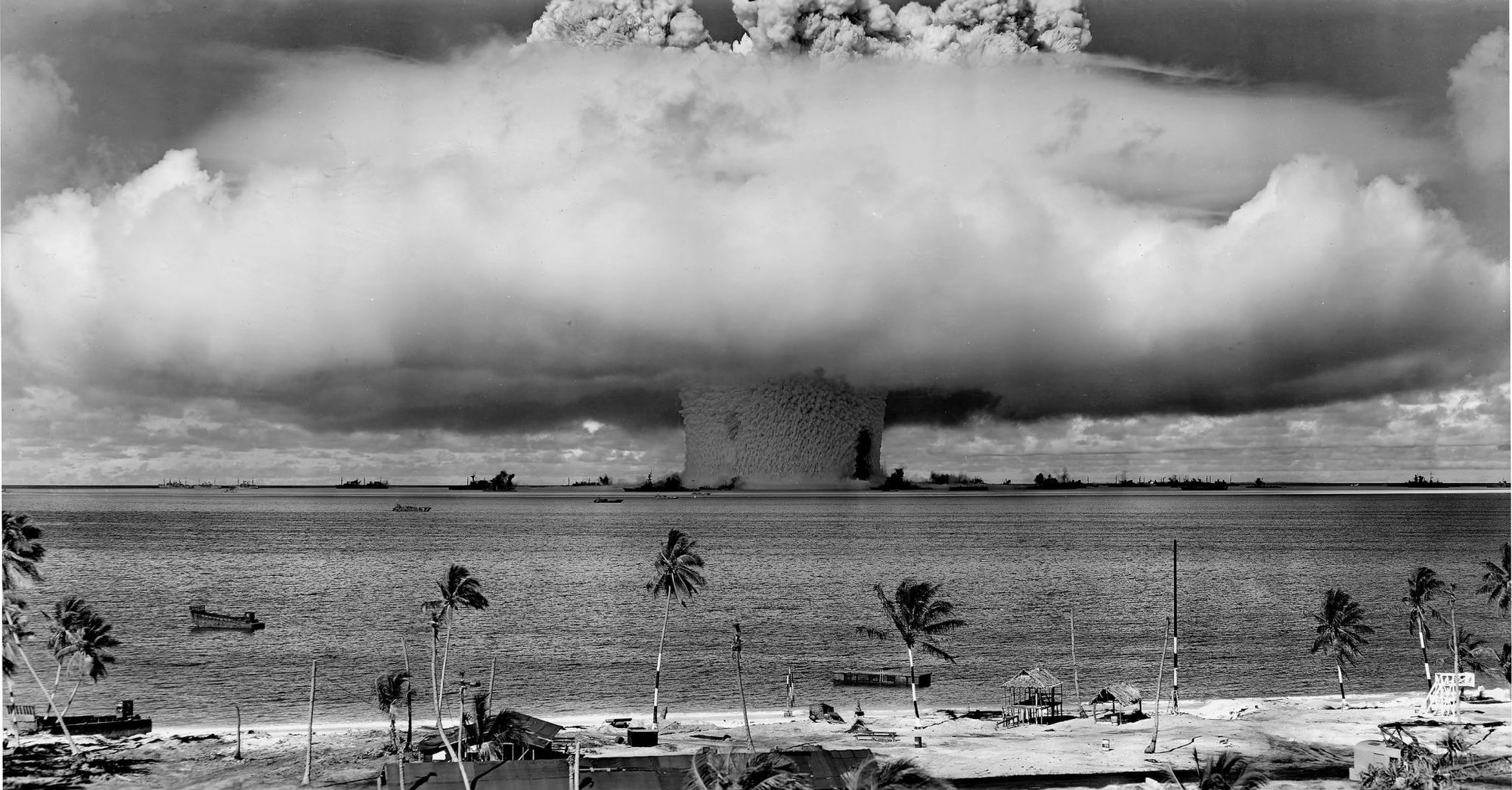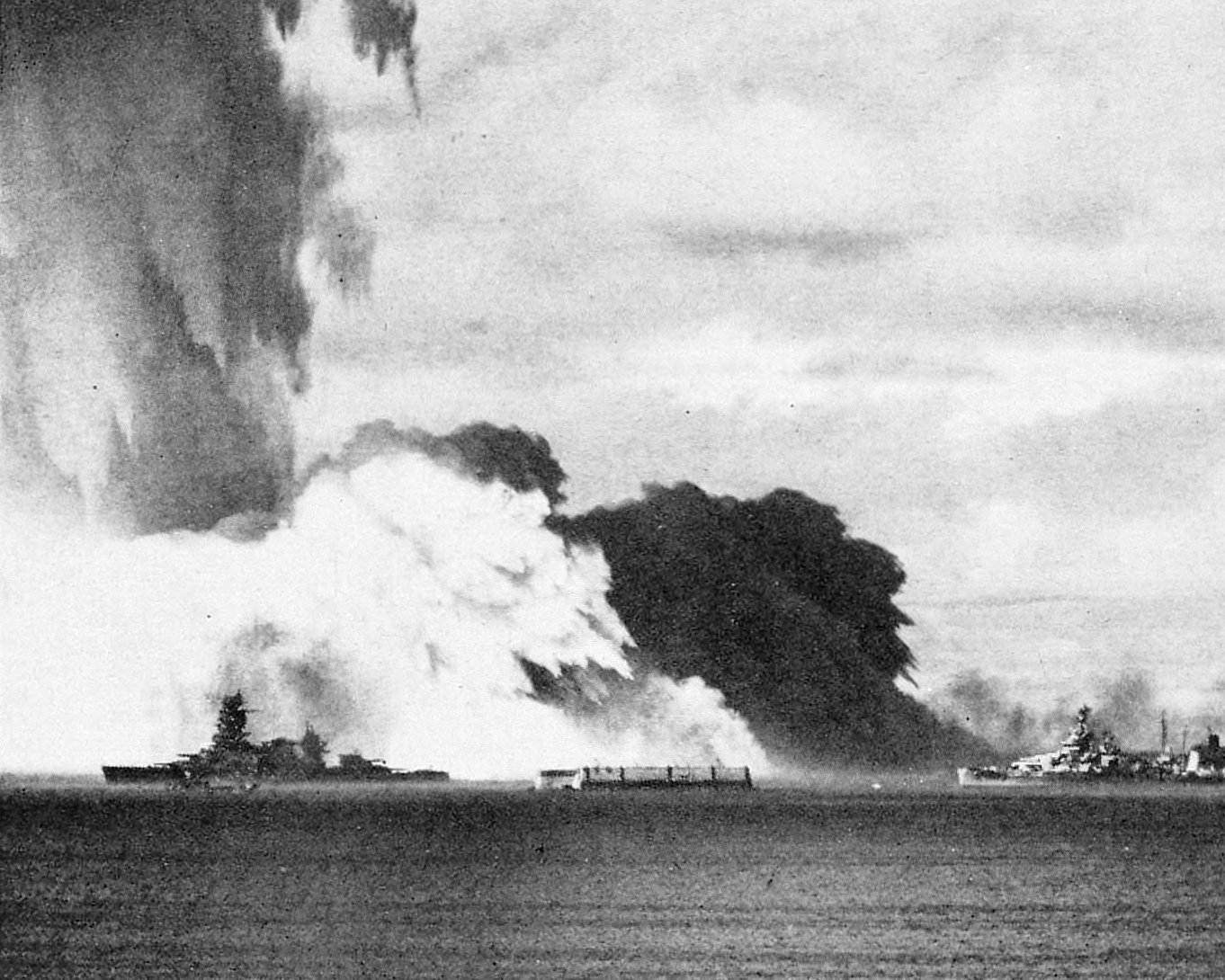
The “Baker” explosion, part of Operation Crossroads, a United States military nuclear weapons test at Bikini Atoll in the Marshall Islands, July 25, 1946. Photo courtesy of Wikimedia Commons.
On the morning of July 25, 1946, a spectacular explosion shot radioactive seawater some 6,000 feet into the air at a Bikini Atoll lagoon in the Marshall Islands. A mushroom cloud climbed above the epicenter of the blast, where a nuclear device — called Helen of Bikini — had been anchored 90 feet beneath a floating barge. The detonation generated a tidal wave the size of a skyscraper. The shock wave raced across the lagoon and engulfed the targeted fleet of 90 aging American, German, and Japanese battleships. When the violence of the first underwater nuclear explosion had finally ceased, eight surplus warships had been sunk. The radioactive fallout damaged several more.
The remarkable display of nuclear firepower was the second and final test of the coordinated military exercise code-named Operation Crossroads.
In the wake of the destruction of the Japanese cities Hiroshima and Nagasaki, the US military wanted to know more about the awesome new weapons it wielded. In particular, would battleships become obsolete in the nuclear era? To test the effects of nuclear weapons on warships — as well as on various materials and even animals — the US military embarked on Operation Crossroads.
Unlike previous nuclear tests, which had been conducted under the strictest secrecy protocols, the Crossroads tests were announced to the public beforehand. The international press received invitations to join the audience, which included foreign officials such as observers from China and the Soviet Union. The international involvement made the operation “the most observed, most photographed, most-talked-of scientific test ever conducted,” according to the official report on the operation.
The scale of the operation was enormous. The targeted fleet was a mishmash of more than 90 American, Japanese, and German aircraft carriers, cruisers, destroyers, submarines, and amphibious vessels. While the targeted fleet was empty of human passengers, some of the ships were loaded with animals. Some 204 goats, 200 pigs, 200 mice, and 5,000 rats were placed in the blast zone.
The scientists chose each animal with particular responses to the explosions in mind. Goats were chosen because of their humanlike weights and respiratory systems. Pigs have similar skin to humans, and scientists wanted to investigate how their skin reacted to radiation. And the mice were present to investigate the development of cancer.
More than 150 ships housed the 42,000 participating military personnel. The logistical support of the operation comprised some 156 airplanes, 750 cameras, 5,000 pressure gauges, and 25,000 radiation recorders. And for good measure, 4,000 pounds of coffee, 11,000 pounds of sugar, 38,000 pounds of fruit, 40,000 pounds of meat, 89,000 pounds of vegetables, and 70,000 candy bars were also packed for the trip.

The Crossroads tests were planned to total three test shots: Able, Baker, and Charlie. The Able bomb was dropped from a B-29 bomber. The Baker bomb was detonated under a barge. And the Charlie test was set to include another underwater detonation that targeted a group of salvaged submarines. The Able and Baker tests’ atomic bombs each had a yield of 23 kilotons. The Baker test produced so much radioactive contamination that President Harry Truman decided to cancel the Charlie test.
Although the Able test on July 1, 1946, missed the targeted fleet by at least 1,500 feet, five ships still sank. According to an assessment by the Bulletin of the Atomic Scientists, “A large ship, about a mile away from the explosion, would escape sinking, but the crew would be killed by the deadly burst of radiations from the bomb, and only a ghost ship would remain, floating unattended in the vast waters of the ocean.”
Operation Crossroads was ultimately terminated on Aug. 10, 1946, because of safety concerns regarding radioactive fallout. The Joint Chiefs of Staff Evaluation Board noted the contaminated ships “became radioactive stoves, and would have burned all living things aboard them with invisible and painless but deadly radiation.”
The successful tests of Able and Baker, however, sparked an atomic arms race leading into the Cold War. “If used in numbers, atomic bombs not only can nullify any nation’s military effort, but can demolish its social and economic structures and prevent their reestablishment for long periods of time,” the JCS board concluded in 1947. “With such weapons, especially if employed in conjunction with other weapons of mass destructions, for example, pathogenic bacteria, it is quite possible to depopulate vast areas of the earth’s surface, leaving only vestigial remnants of man’s material works.”
Read Next:

Matt Fratus is a history staff writer for Coffee or Die. He prides himself on uncovering the most fascinating tales of history by sharing them through any means of engaging storytelling. He writes for his micro-blog @LateNightHistory on Instagram, where he shares the story behind the image. He is also the host of the Late Night History podcast. When not writing about history, Matt enjoys volunteering for One More Wave and rooting for Boston sports teams.
BRCC and Bad Moon Print Press team up for an exclusive, limited-edition T-shirt design!
BRCC partners with Team Room Design for an exclusive T-shirt release!
Thirty Seconds Out has partnered with BRCC for an exclusive shirt design invoking the God of Winter.
Lucas O'Hara of Grizzly Forge has teamed up with BRCC for a badass, exclusive Shirt Club T-shirt design featuring his most popular knife and tiomahawk.
Coffee or Die sits down with one of the graphic designers behind Black Rifle Coffee's signature look and vibe.
Biden will award the Medal of Honor to a Vietnam War Army helicopter pilot who risked his life to save a reconnaissance team from almost certain death.
Ever wonder how much Jack Mandaville would f*ck sh*t up if he went back in time? The American Revolution didn't even see him coming.
A nearly 200-year-old West Point time capsule that at first appeared to yield little more than dust contains hidden treasure, the US Military Academy said.












